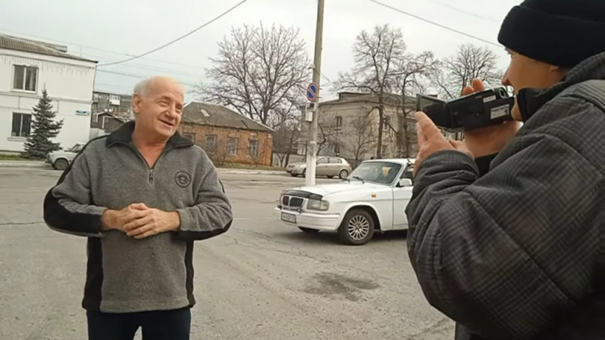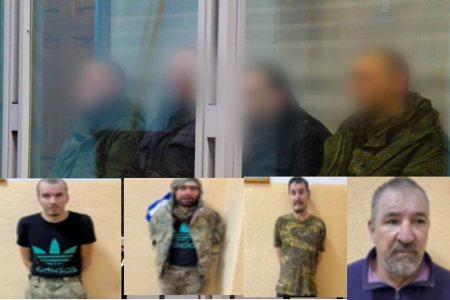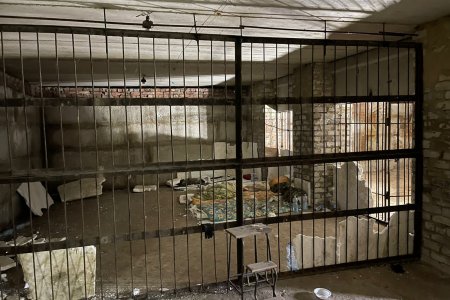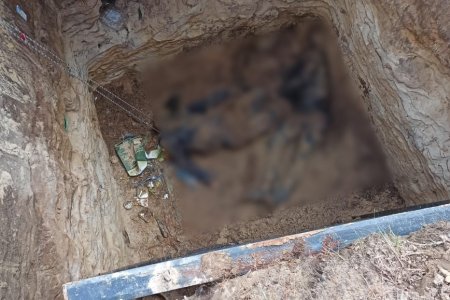
69-year-old Anatoliy Harahatyy was seized by the Russian invaders of his native Kharkiv oblast in May 2022. He was held prisoner in intolerable conditions for 100 days, during which time the Russians tortured him and threatened to execute him if he did not agree to collaborate. During interrogations, these representatives of the aggressor state which claims to have invaded Ukraine “to protect Russian-speakers” inflicted electric shocks on the elderly Ukrainian when he replied in his native language.
Harahatyy is from Savyntsi, an urban-type settlement, near Balakliya in the Kharkiv oblast. Although he was probably one of the oldest of the local residents held prisoner by the invaders, the account he has given to the local publication Slobidsky Krai is one of very many, with all involving torture and horrific conditions. Investigators began uncovering the premises used to imprison and torture Ukrainian civilians after the Russians were driven out in September 2022, as well as mass graves and other evidence of war crimes.
Photography was Harahatyy’s profession and his hobby, and shortly before Russia’s full-scale invasion, he had begun a video blog on YouTube, which had already gained quite a large number of subscribers.
During the initial phase of Russia’s aggression (from 2014), Harahatyy became a volunteer, and joined others in taking food, warm items, and even burners to the Ukrainian soldiers defending Donbas in what was then known as the Anti-Terrorist Operation [ATO]. He explained in the interview to Slobidsky Krai that in all the places in Donbas that he went to as a volunteer, he shot video footage. He says that this “was obvious proof that Russia really is a terrorist state”, and was shocked when those that he showed it to would simply not believe this and even laughed. He had been inspired by Euromaidan [now known as the Revolution of Dignity] and wanted that spirit of change to be felt in his native Savyntsi.
Then, however, the Russians invaded, and gained control of that part of Kharkiv oblast. Harahatyy was out there, on 2 March, videoing the Russian tank column that invaded Savyntsi. Soon afterwards he posted the video footage on social media, terrifying not only his neighbours, but also his wife of almost half a century. She pleaded with him to stop filming the consequences of the Russian invasion, but he refused, agreeing only to move to their dacha. They hoped that he would be safer from the invaders there.
At 6 a.m. on 28 May, however, armed and masked Russians burst into his courtyard. He tried to hide, but they found him, and also ‘searched’ every part of the dacha, as well as of his flat. ‘Search’ in all such cases is to be taken very loosely as the invaders took not only all of his documents and video camera, but also whatever they could lay their hands on. This included a gold chain that he and his wife had sacrificed their wedding rings in order to buy for their only granddaughter’s graduation.
He was initially taken to the garage of the Savyntsi Council building with a Russian ‘investigator’ (who, unlike the others, did not hide his face) turning up and carrying out the first interrogation. The Russians accused him of guiding Ukrainian Armed Forces fire and passing on their location to Ukrainian defenders, all of which he denied. This so-called ‘investigator’ then ordered the other Russians to attach wires to his fingers, with increasing amounts of excruciatingly painful electric currents passed through him. The 69-year-old lost consciousness after the second such dose, but came to fairly quickly. They then put a bag over his head, forced him into a car and took him to the police temporary holding unit in Balakliya where he was thrown on the floor, with the bag over his head and his hands tied behind his back.
He was held prisoner there for 100 days, with eight hostages packed into a cell intended for three. The conditions were appalling, with the men only taken outside once a day for five minutes to the toilet, and otherwise held in a stuffy, overcrowded cell. They were given only some kind of porridge, with the Russians only twice, towards the very end, agreeing to pass on the parcels of food, items of hygiene, etc that his wife tried to get to him. During his ordeal, he lost a huge amount of weight.
During the first interrogation there, the Russians again tried to get him to admit to passing on information to the Ukrainian Armed Forces. They, of course, asked in Russian, and inflicted electric shocks each time he answered in his native Ukrainian.
The Russians were not just intent on claiming that he had directed Ukrainian fire, but also tried to get him to praise the regime of Russian leader Vladimir Putin, with propaganda clips. He consistently refused to collaborate. Then, during the third interrogation, the ‘investigator’ ordered that he place both hands on the table. Harahatyy earlier lost one finger, and the Russian threatened that if he did not agree to collaborate, they would chop off the other fingers “for symmetry”.
It was at that point, the elderly man explains, that he almost capitulated. He said that he would cooperate, however that night he lay awake, unable to sleep, and in the morning told them he had changed his mind. “I’ve already lived a long time, and not a lot of time remains for me … I’ll die and meet the souls of my parents. How will I endure their reproach? No, I’ve lived as a decent man and will go into the next world unchanged.”
The Russian replied that he would be executed in an hour. Back at the cell, he asked his fellow hostages to pass on to his wife and children how much he loved them, how happy he had been with them. He asked them to say that he was sorry for the pain he was causing them, but that he could not behave otherwise.
He later explained to Tetiana Chmut from Slobidsky Krai that he was grateful to the unseen forces within him that had stopped him from such betrayal. One of the reasons he had been stopped from doing so, he said, was the awareness that he would have been the first of the men to thus capitulate. He was also the oldest, and it would have made it easier for the others then to also give in.
The threat to kill him was, thankfully, empty. It was a full three weeks later that they came for him, and only to yet again try to force him to collaborate. He again refused.
He and another man were released on 4 September, with the Russians threatening to kill him if he again used his video camera. In fact, it was they who fled the advancing Ukrainian Army which, two days later, liberated Balakliya.
Anatoliy Harahatyy has indeed taken up his video camera again and is ensuring video footage of the crimes that the invaders committed and the devastation that they left behind in the Balakliya and Izium parts of Kharkiv oblast. His videos can be found here. In one of these videos, Anatoliy Tutov from Balakliya provides a harrowing account of the beatings, the electric current and other forms of torture that he was subjected to while imprisoned by the Russian invaders. It was, he said, like 1937 [the worst year of Stalin’s Terror], but now this was no longer in films, but something he was himself experiencing. Tutov was held prisoner with many other Ukrainian civilians, all of whom went through the same hell. He fears that those who disappeared were probably killed.
See also: Russia left a trail of mined kindergartens and torture chambers in Kharkiv oblast



